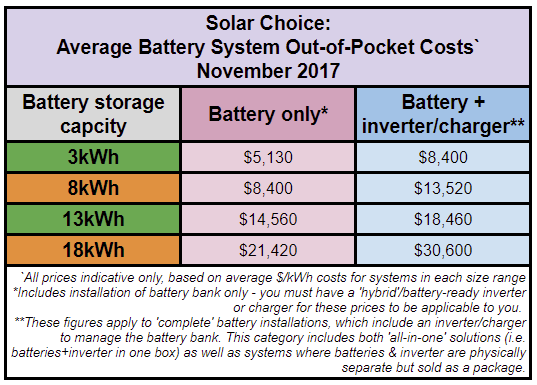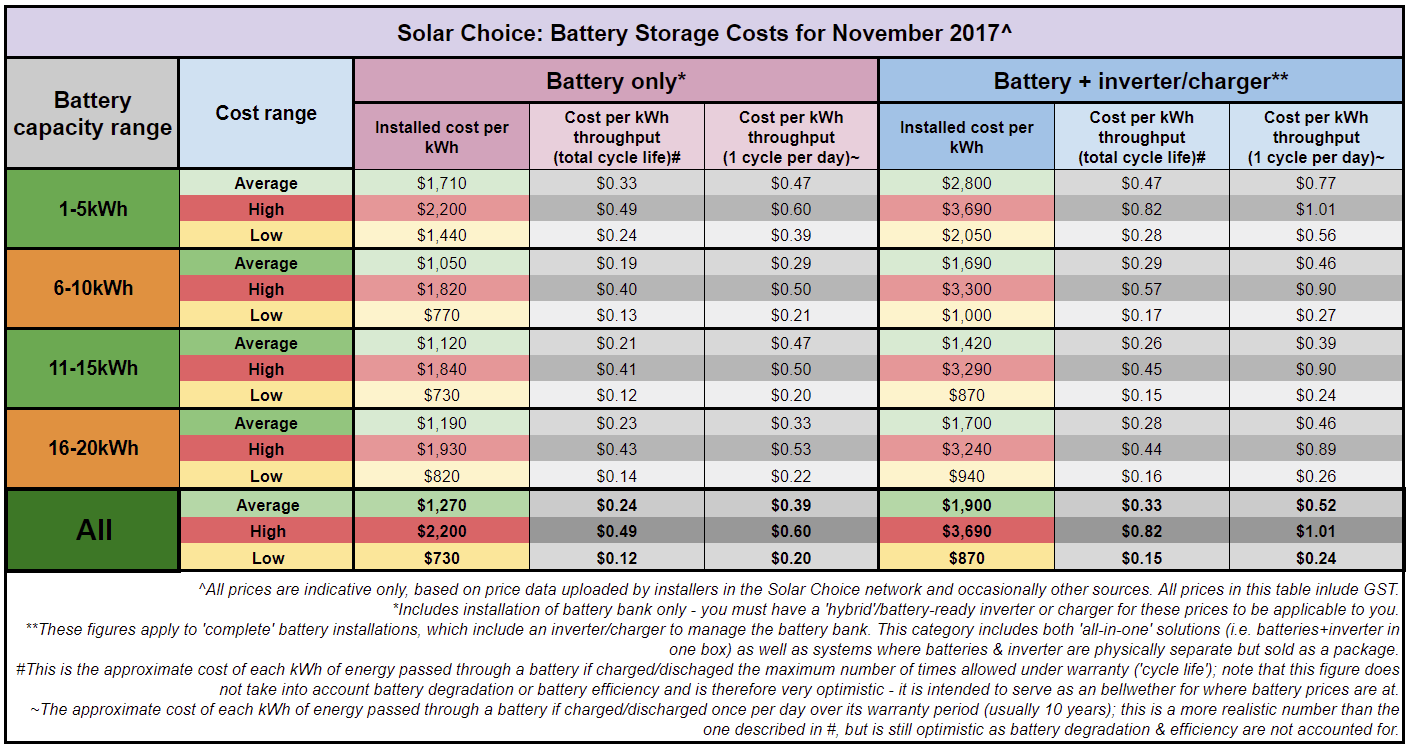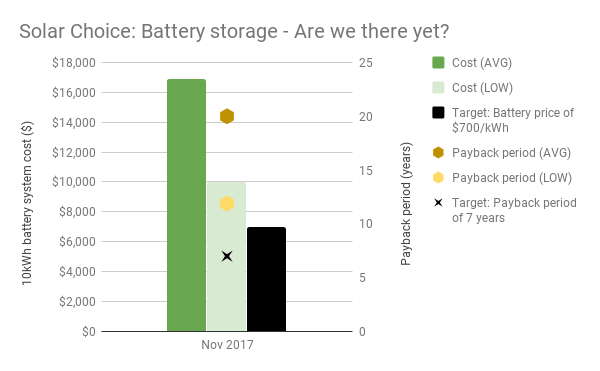We’re excited to announce that we have at long last published our first Battery Storage Price Index – a generalised view of what it costs to have a battery storage system installed in Australia.
If you’ve done any research into the battery storage market at all, you’ve probably already worked out that batteries are complicated. Especially in light of the current (high) price points, it’s difficult to work out whether batteries are worth it for your home – they’re not yet on par with solar panel systems in terms of their cost and the value that they deliver. (You can see current solar system prices here.)
This means that organising & presenting battery pricing is a bit more complicated than solar system prices, and this complexity is further compounded by the fact that battery systems come in a range of sizes & size increments. That being said, we’ve tried our best to condense all the information into the most palatable (but still meaningful) formats possible.
Important note: None of the prices & costs detailed below include the installation of a solar system. For current solar system prices, please visit our Current Solar System Prices page.
You can also instantly compare solar & battery quotes for your area by filling out the form on this page:
Compare Solar & Battery Quotes
Average out-of-pocket battery installation prices – November 2017
The table below displays average, indicative battery installation prices from a range of installers around Australia, most of whom are active in the Solar Choice network. Prices include installation and GST.
Click to enlarge.
Not sure what battery size is right for your home? Check out our Quick Guide to Sizing Residential Solar & Battery Systems
Some further information and explanations about the numbers:
- We do not yet have sufficient data to publish state-by-state or city-by-city figures, so the below should be viewed as a bellwether for battery prices nationally. Furthermore, all prices are based on a relatively small sample size (about eight different companies); we expect this number to grow – and the accuracy of this index to improve – as time goes on.
- Pricing figures are based on a range of battery size offerings in four size ‘buckets’ (1-5kWh, 6-10kWh, 11-15kWh, 15-20kWh); the 3kWh, 8kWh, 13kWh and 18kWh battery capacity sizes used in the table below are the ‘middle size’ battery bank from each of these buckets, and the prices were generated by multiplying each number by the average $/kWh system sizes for each bucket (detailed in the second table in this article). We did this because it was the easiest way to give readers an idea of what they’d be looking to pay for a battery system.
- All the battery products use some lithium variant and have a 10 year warranty. The battery brands included this month are LG Chem (RESU line, various sizes), Tesla Powerwall 2 (13.2kWh), Enphase AC Battery (1.2kWh), and Pylontech (various sizes). Inverter brands included are Redback, Sungrow, SolaX & Goodwe.
- We differentiate between ‘battery only’ installations and ‘battery + inverter/charger systems’. Battery only prices apply to households that either a) already have a solar system with a battery-ready inverter installed and want to retrofit batteries to it (assuming of course, that the batteries in question are compatible with that inverter), or b) plan on having a hybrid/battery-ready inverter installed with a new solar system. Please note that not all batteries products have a ‘battery only’ equivalent – Tesla’s Powerwall 2 and Enphase’s AC Battery, for example, both have inbuilt inverters (whose cost is included alongside the battery), while LG Chem’s RESU line & Pylontech’s products are battery banks without inverters (although they do require an inverter to operate, it is possible to ‘double up’ with a hybrid inverter for your solar).
- Which one do you need?
- You’ve already got solar: If you already have a solar system with a hybrid inverter, the ‘battery only’ price may apply to you if you find compatible batteries. If you already have solar but without a hybrid inverter, the ‘battery + inverter/charger’ pricing is probably right for you.
- You don’t have solar yet: If you do not yet have solar, and you definitely know you want batteries, the ‘battery only’ column will only apply to you if you end up purchasing a system with a hybrid/battery-ready inverter. The battery+inverter/charger column will apply to you if you’re considering a battery product that has its own inverter (e.g. Powerwall or Enphase AC Battery) to go with your solar system.
- Which one do you need?
Average, high & low battery installation prices – November 2017
The table below is pretty information-dense, so make sure that you read the footnotes and the text below.
Click to enlarge.
In this table we try to provide a clear idea of battery value. When comparing battery systems, people in the industry typically speak in terms of ‘dollars per kilowatt-hour’ ($/kWh) of storage capacity. This is an easy shortcut for discussing battery value (which is why we’ve included it), but doesn’t tell the full story as different batteries can tolerate different levels of use. For example, some batteries may only be charged/discharged (‘cycled’) once daily, while others can by cycled up to 2.7x per day (see: sonnen) without voiding the warranty.
To this end, we’ve also included figures on ‘energy throughput‘. The energy throughput metric gives you an idea of how much you’ll pay for each kWh of energy that you pass through the battery over its lifespan.
We’ve looked at two scenarios:
- If you cycle the battery as many times as its cycle life will allow per day (total cycle life), or
- If you cycle it only once per day (which is the more realistic scenario since most homes will charge their batteries only with the sun and not with the grid – c.f. tariff arbitrage).
As noted in the footnotes of the image above, these figures are highly indicative and are intended to serve as a means of comparison between battery products – they do not take into account battery degradation or efficiency.
Compare Solar & Battery Quotes
Introducing the ‘Are we there yet?’ Meter

Battery storage is the most talked-about topic in our industry, but when it comes to uptake numbers batteries are not anywhere close to where solar PV systems are. One of the main reasons for this is cost – batteries are much more expensive than solar systems, and the value they deliver in terms of energy bill savings is not as great as solar on its own.
We’ve taken it upon ourselves to set a gauge for the overall state of affairs when it comes to battery storage with the creation of our ‘Are we there yet?’ Meter (the chart below). We look at the national average & low battery prices for a moderately-sized (10kWh) ‘full’ battery system (not a specific product, but more an amalgamation of various products that we’ve seen) and see how the estimated payback periods stack up against a theoretical ‘ideal’ payback period of 7 years; we see this 7 year mark as being a reasonable marker of the battery market being where it needs to be to make sense for most households (the ‘there’ in ‘are we there yet?’).
We’ve also set a target $700/kWh figure for batteries (specifically lithium with a 10 year warranty) as a marker for general battery affordability. One of the biggest hurdles to battery storage uptake in Australia is the up-front costs associated with batteries. At this price point, a 10kWh battery system would cost roughly $7,000 and a 5kWh battery system would cost about $3,500 – tenable (if not negligible) amounts to pay for something that will go a long way towards minimising electricity bills and upping a home’s energy independence.
Note that this is the payback period for the work that the battery does ‘shifting’ solar energy to evening use, and excludes direct solar benefits – calculated using our Solar & Battery Storage Sizing & Payback Estimator Tool. Payback periods for ‘whole’ solar+storage systems – those viewed as a single unit – will already come in at under 10 years in many places. Also note that it doesn’t take into account the fact that there’s an opportunity cost associated with putting your solar into batteries instead of earning a feed-in tariff for it – which actually makes batteries less appealing.
Other assumptions: The model scenario assumes a house with a 5kW solar system and an average daily energy consumption level of 25kWh on the ‘evening peak’ consumption pattern. This hypothetical house is located in Sydney (which gets a middling amount of sunlight). We also use some average electricity prices for both flat rate & time of use tariffs, then average the payback periods between those two.
So is battery storage there yet?
At just over $1,000/kWh for systems on the ‘low’ end of the price spectrum, and with payback periods coming in at just over 10 years, we’re close enough for lots of Australians to justify making an investment in batteries to themselves (as many already are) but not yet in the territory of ‘mass appeal’.
Remember that this chart is meant to reflect the national situation as an amalgamated whole – your individual circumstances (including the state you live in, the amount you pay for electricity & the deal you get on a battery system) may be conducive to shorter payback systems, so we encourage you to look into it for yourself.
(You can get battery system pricing by requesting a Quote Comparison through our system. You can evaluate battery viability for your situation using our Solar & Battery Storage Sizing & Payback Estimator Tool.)
Click to enlarge.
About this data
Tables and charts included in this article were compiled using data from Solar Choice’s installer network database (as well as a couple of outside sources), which contains regularly-updated pricing and product details from over 100 solar & battery installation companies across Australia. Prices do not ordinarily incorporate meter installation fees or additional costs for difficult installations.
Compare Solar & Battery Quotes
© 2019 Solar Choice Pty Ltd
- Solar Power Wagga Wagga, NSW – Compare outputs, returns and installers - 13 March, 2025
- Monocrystalline vs Polycrystalline Solar Panels: Busting Myths - 11 November, 2024
- Solar Hot Water System: Everything You Need to Know - 27 February, 2024

